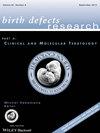Jorge Rosenthal, Mary-Elizabeth Reeve, Nicte Ramirez, Krista S. Crider, Joe Sniezek, Claudia Vellozzi, Owen Devine, Eunice Lopez-Pazos
下载PDF
{"title":"2009年至2010年危地马拉非怀孕育龄妇女红细胞叶酸不足:患病率和预测神经管缺陷风险","authors":"Jorge Rosenthal, Mary-Elizabeth Reeve, Nicte Ramirez, Krista S. Crider, Joe Sniezek, Claudia Vellozzi, Owen Devine, Eunice Lopez-Pazos","doi":"10.1002/bdra.23499","DOIUrl":null,"url":null,"abstract":"<div>\n \n <section>\n \n <h3> Background</h3>\n \n <p>The World Health Organization recently released recommendations stating that red blood cell (RBC) folate concentrations should be above 400 ng/L (906 nmol/L) for optimal prevention of folate-sensitive neural tube defects (NTDs). The objective of this study was to determine the distribution of folate insufficiency (FI) (<906 nmol/L) and potential risk of NTDs based on RBC folate concentrations among nonpregnant women of child-bearing age in Guatemala.</p>\n </section>\n \n <section>\n \n <h3> Methods</h3>\n \n <p>A national and regional multistage cluster probability survey was completed during 2009 to 2010 among Guatemalan women of child-bearing age 15 to 49 years of age. Demographic and health information and blood samples for RBC folate analyses were collected from 1473 women. Prevalence rate ratios of FI and predicted NTD prevalence were estimated based on RBC folate concentrations comparing subpopulations of interest.</p>\n </section>\n \n <section>\n \n <h3> Results</h3>\n \n <p>National FI prevalence was 47.2% [95% confidence interval, 43.3–51.1] and showed wide variation by region (18–81%). In all regions, FI prevalence was higher among indigenous (27–89%) than among nonindigenous populations (16–44%). National NTD risk based on RBC folate concentrations was estimated to be 14 per 10,000 live births (95% uncertainty interval, 11.1–18.6) and showed wide regional variation (from 11 NTDS in the Metropolitan region to 26 NTDs per 10,000 live births in the Norte region).</p>\n </section>\n \n <section>\n \n <h3> Conclusion</h3>\n \n <p>FI remains a common problem in populations with limited access to fortified products, specifically rural, low income, and indigenous populations. However, among subpopulations that are most likely to have fortified food, the prevalence of FI is similar to countries with well-established fortification programs. Birth Defects Research (Part A) 106:587–595, 2016. © 2016 Wiley Periodicals, Inc.</p>\n </section>\n </div>","PeriodicalId":8983,"journal":{"name":"Birth defects research. Part A, Clinical and molecular teratology","volume":"106 7","pages":"587-595"},"PeriodicalIF":0.0000,"publicationDate":"2016-03-24","publicationTypes":"Journal Article","fieldsOfStudy":null,"isOpenAccess":false,"openAccessPdf":"https://sci-hub-pdf.com/10.1002/bdra.23499","citationCount":"17","resultStr":"{\"title\":\"Red Blood Cell Folate Insufficiency among nonpregnant Women of Childbearing age in Guatemala 2009 to 2010: Prevalence and predicted Neural Tube Defects risk\",\"authors\":\"Jorge Rosenthal, Mary-Elizabeth Reeve, Nicte Ramirez, Krista S. Crider, Joe Sniezek, Claudia Vellozzi, Owen Devine, Eunice Lopez-Pazos\",\"doi\":\"10.1002/bdra.23499\",\"DOIUrl\":null,\"url\":null,\"abstract\":\"<div>\\n \\n <section>\\n \\n <h3> Background</h3>\\n \\n <p>The World Health Organization recently released recommendations stating that red blood cell (RBC) folate concentrations should be above 400 ng/L (906 nmol/L) for optimal prevention of folate-sensitive neural tube defects (NTDs). The objective of this study was to determine the distribution of folate insufficiency (FI) (<906 nmol/L) and potential risk of NTDs based on RBC folate concentrations among nonpregnant women of child-bearing age in Guatemala.</p>\\n </section>\\n \\n <section>\\n \\n <h3> Methods</h3>\\n \\n <p>A national and regional multistage cluster probability survey was completed during 2009 to 2010 among Guatemalan women of child-bearing age 15 to 49 years of age. Demographic and health information and blood samples for RBC folate analyses were collected from 1473 women. Prevalence rate ratios of FI and predicted NTD prevalence were estimated based on RBC folate concentrations comparing subpopulations of interest.</p>\\n </section>\\n \\n <section>\\n \\n <h3> Results</h3>\\n \\n <p>National FI prevalence was 47.2% [95% confidence interval, 43.3–51.1] and showed wide variation by region (18–81%). In all regions, FI prevalence was higher among indigenous (27–89%) than among nonindigenous populations (16–44%). National NTD risk based on RBC folate concentrations was estimated to be 14 per 10,000 live births (95% uncertainty interval, 11.1–18.6) and showed wide regional variation (from 11 NTDS in the Metropolitan region to 26 NTDs per 10,000 live births in the Norte region).</p>\\n </section>\\n \\n <section>\\n \\n <h3> Conclusion</h3>\\n \\n <p>FI remains a common problem in populations with limited access to fortified products, specifically rural, low income, and indigenous populations. However, among subpopulations that are most likely to have fortified food, the prevalence of FI is similar to countries with well-established fortification programs. Birth Defects Research (Part A) 106:587–595, 2016. © 2016 Wiley Periodicals, Inc.</p>\\n </section>\\n </div>\",\"PeriodicalId\":8983,\"journal\":{\"name\":\"Birth defects research. Part A, Clinical and molecular teratology\",\"volume\":\"106 7\",\"pages\":\"587-595\"},\"PeriodicalIF\":0.0000,\"publicationDate\":\"2016-03-24\",\"publicationTypes\":\"Journal Article\",\"fieldsOfStudy\":null,\"isOpenAccess\":false,\"openAccessPdf\":\"https://sci-hub-pdf.com/10.1002/bdra.23499\",\"citationCount\":\"17\",\"resultStr\":null,\"platform\":\"Semanticscholar\",\"paperid\":null,\"PeriodicalName\":\"Birth defects research. Part A, Clinical and molecular teratology\",\"FirstCategoryId\":\"1085\",\"ListUrlMain\":\"https://onlinelibrary.wiley.com/doi/10.1002/bdra.23499\",\"RegionNum\":0,\"RegionCategory\":null,\"ArticlePicture\":[],\"TitleCN\":null,\"AbstractTextCN\":null,\"PMCID\":null,\"EPubDate\":\"\",\"PubModel\":\"\",\"JCR\":\"Q\",\"JCRName\":\"Medicine\",\"Score\":null,\"Total\":0}","platform":"Semanticscholar","paperid":null,"PeriodicalName":"Birth defects research. Part A, Clinical and molecular teratology","FirstCategoryId":"1085","ListUrlMain":"https://onlinelibrary.wiley.com/doi/10.1002/bdra.23499","RegionNum":0,"RegionCategory":null,"ArticlePicture":[],"TitleCN":null,"AbstractTextCN":null,"PMCID":null,"EPubDate":"","PubModel":"","JCR":"Q","JCRName":"Medicine","Score":null,"Total":0}
引用次数: 17
引用
批量引用

 求助内容:
求助内容: 应助结果提醒方式:
应助结果提醒方式:


